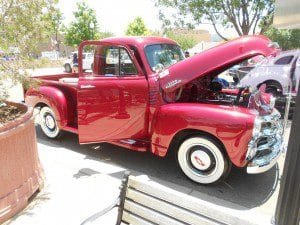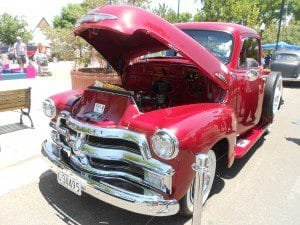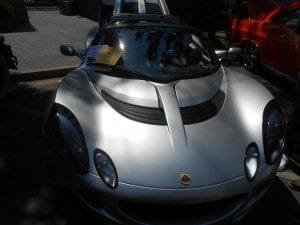On of the first things to note about classic Chevy trucks during the 1950’s was that there was a series built beginning in late 1955 which differed in several ways from the 1954 model Chevy truck shown in this article. While major changes were planned for the late 1955 model year trucks, Chevrolet did make some significant changes to it’s 1954 model as opposed to it’s 1953 design. This is notable because beginning in 1955 there were major changes all around.

The Chevy Pick-Up truck line from the years 1947 to early 1955 were named “Advance Design” trucks. The 1945 to 1947 models built had a lot in common with the pre war designs. There were a lot of changes made in the Advance Design compared to the pre World War Two models. For one thing, the Advance Design models were considered much roomier.
The Advance Design cabs were eight inches wider and seven inches longer. The cabs were also entirely welded together as opposed to some welding and bolting. The larger cab also had the effect of making the entire truck look larger. They were also considered sleeker and stronger and the cab doors were widened helping to make entry and exit easier. Three different models of the Advance Design classic Chevy truck was offered.. Three-quarter ton, half ton and one ton. Theses new post war designed trucks which represented a major design change were a big success for Chevrolet since they were the largest selling pick-up truck from 1947 through 1954.

Among the significant changes in the 1954 Chevy truck and the first noticed from the outside was the single curved windshield and a larger rear window. This was marketed as providing more safety while turning and backing up. Better viewing all around compared to the 1953 model. Another change was a lower loading height for the pick-up’s bed. The 1954 model year changes also included a new hood ornament and hubcaps showing Chevy “Bow Ties” as well as round tail lights in place of rectangular. The 1954 Chevy truck engine also had a tighter compression ratio and 112 HP. The dashboard was also redesigned for the 1954 model. a new hood ornament, and hubcaps sporting Chevy “bow ties.” There were a lot of significant changes in Chevy Pick-Up trucks starting with the 1955 model year. The 1954 Chevy truck shown here had a V-6 engine. Ford Motor Company had come out with a V-8 in 1954 beating Chevy by one year. The 1955 Chevy Pick-Up that was introduced in late 1955 came with a 265 cubic inch OHV V-8 which became very popular.
See our AutomuseumOnline article on the 1937 GMC COE Truck

In fact, while Chevy was a year late with the OHV V-8’s in their pick-up trucks, when they did come out, Chevy took the lead away from Ford. The engine change was just one difference from 1954 to 1955 although a very big one. Other changes included a wrap around windshield, power brakes and power steering. The old Chevy trucks built from late 1955 to 1959 were named the “Task Force” series. The first 1955 model was called the “1st Series” and the late 1955 model was the “2nd Series“.
For the automobile and truck restorer, the Advance Design Chevy trucks are considered good vehicles to fix up. Parts are readily available and prices on fully restored Advance Design Chevy Trucks are pretty good. As always, prices will fluctuate widely depending on the quality of the restoration and exact model year and tonnage. A fully restored 1953 or 1954 might get from $20,000 to $30,000. Levels of restoration can vary and a truck’s precise condition will greatly influence price. If you search for a Advanced Design Chevy Truck which has not been restored, you might pay in the area of $1,500 or so. If you can get a hold of one of these trucks at a reasonable price, classic Chevy trucks have been known to make ideal auto restoration projects.
(Photos from author’s private collection)


